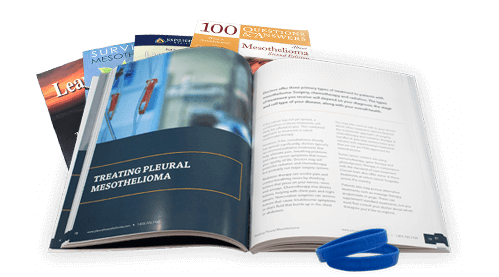The most common and specialist-recommended modalities used to treat mesothelioma are surgery, chemotherapy and radiation. This trimodal therapy is highly recommended to early-stage patients by many cancer centers, including the NCI National Comprehensive Cancer Center and Brigham and Women’s Hospital in Massachusetts.
In more recent years, the use of experimental therapies, including immunotherapy and photodynamic therapy, in conjunction with conventional modalities has also improved patient survival rates and overall quality of life.
Mesothelioma treatment options vary based on each patient’s circumstances. The best way to learn about your treatment options is to contact a mesothelioma doctor.
History of Multimodal Therapy
The method of combining different treatment modalities, which eventually became known as multimodal therapy, began when researchers discovered that patients typically experienced a better survival rate when they used a combination of treatment therapies rather than just one treatment option.
Antman, et al. conducted a study of 180 patients in the early 1980s that proved the combination of chemotherapy and radiation therapy with extrapleural pneumonectomy (EPP) gave the most favorable treatment results for pleural mesothelioma.
Another study, conducted by Sugarbaker, et al. sought to identify the prognosis for long-term survival in trimodality management of malignant pleural mesothelioma. It showed that patients diagnosed with the epithelial cell type of pleural mesothelioma, with no lymph node metastasis, who were treated with a combination of chemotherapy, hemithoracic radiation therapy and EPP, showed a two-year survival rate of 38 percent and a five-year survival rate of 15 percent.
The most common and specialist-recommended modalities used to treat pleural mesothelioma are surgery, chemotherapy and radiation. This trimodal therapy is highly recommended to early-stage patients by many cancer centers, including the NCI National Comprehensive Cancer Center and Brigham and Women’s Hospital in Massachusetts.
In more recent years, the use of experimental therapies, including immunotherapy and photodynamic therapy, in conjunction with conventional modalities has also improved patient survival rates and overall quality of life.
Treatment options vary based on each patient’s circumstances. The best way to learn about your treatment options is to contact a mesothelioma specialist.

Tailored Treatment Combinations
Although studies have reported positive findings for certain multimodal therapies, each patient is likely to respond differently and may receive tailored treatment combinations. Pleural mesothelioma specialists have to consider a number of factors before determining the right multimodal therapy treatment plan for each patient.
Factors to consider before determining the right multimodal therapy treatment plan:
- Cancer stage
- Histological subtype (cell type of the tumor)
- Extent of cancer spreading beyond the lung lining
- Lung health
- Lymph node involvement
- Overall health of patient
- Potential complications, such as underlying heart disease
- Resection margins, the amount of cancer left behind after surgery
- Toxicity of treatment
Surgery, chemotherapy and radiation therapy are the anti-cancer treatment options available to people with pleural mesothelioma. Other treatments, such as immunotherapy, gene therapy and photodynamic therapy, are only available through mesothelioma clinical trials. Patients generally undergo treatment with standard therapies before clinical trials are considered. While immunotherapy and other novel therapies are being used on pleural mesothelioma patients, they are not considered first-line treatment options.
Surgery may help extend survival in select patients when combined with chemotherapy and radiation therapy. The cancer’s stage, or extent of tumor spreading, is the biggest determinant of whether a person will qualify for surgery. If tumors haven’t spread beyond the lung, surgery may be effective.
If the cancer has spread beyond the lung into the diaphragm or other nearby organs, surgery won’t offer any significant survival benefit. Chemotherapy and radiation therapy is the treatment combination of choice for patients who don’t qualify for surgery.
Surgery, Chemotherapy and Radiation Therapy
Trimodal therapy with surgery, chemotherapy and radiation therapy has produced the longest survival rates of any multimodal therapy for pleural mesothelioma. The order in which the treatments are given can vary depending upon the patient, treating physician and treatment center. Surgery often comes first, followed by chemotherapy and then radiation therapy.
Some approaches to treatment use chemotherapy or radiation therapy first to shrink tumors, leaving less cancer to remove in surgery. Tumors that don’t respond to chemotherapy or radiation therapy, a sign of aggressive disease, generally aren’t considered for future surgery.
A study to test the value of radiation therapy before surgery was published in 2014 and found promising results. Eighty-four percent of participants with epithelial cell type tumors lived longer than three years. They also had fewer surgical complications and faster recovery.
Chemotherapy and Radiation Therapy
Multimodal therapy for pleural mesothelioma most often refers to the trimodal combination of surgery, chemotherapy and radiation therapy. Bimodal therapy with chemotherapy and radiation therapy is also technically a form of multimodal therapy. Both have been shown to shrink tumors and improve pain and breathing for people with pleural mesothelioma.
Radiation therapy may be given first to shrink tumors, leaving less cancerous cells for chemotherapy to kill. In some cases, chemotherapy may be given first and radiation therapy will be used if the cancer continues to grow.
A 1996 phase II trial evaluated radiation therapy alone versus the addition of radiation therapy to chemotherapy with doxorubicin and cyclophosphamide. Radiation therapy was applied first, followed by chemotherapy one month later in patients who were otherwise in good health. Median survival for those who only received radiation was six months, versus 13 months for those who received radiation and chemotherapy.
Multimodal Therapy Research
Over the years, research on the effects of various combinations of multimodal therapies to treat pleural mesothelioma has shown promising results, including four-modal therapy treatment plans that combine chemotherapy, surgery, radiation and immunotherapy. Research shows that immunotherapy, a treatment option that utilizes the body’s own immune system to help fight cancer, can be used successfully before or after surgery.
In one study, immunotherapy with interleukin-2, a protein that regulates the activities of white blood cells that are responsible for immunity, was administered to the lung lining before surgery to trigger an immune system response. Treatment was followed by pleurectomy/decortication, post-operative intrapleural chemotherapy, systemic chemotherapy, radiation therapy, and a long-term regimen of interleukin-2. The median survival rate was 26 months.
Radiation therapy is often seen as an important treatment method in multimodal therapy plans. A 2004 trial of intraoperative radiation therapy using brachytherapy (using a radioactive applicator during surgery) found the treatment too toxic for further use. One study that used radiation therapy after EPP showed an average two-year survival rate of 62 percent. Some researchers believe radiation is not as advantageous as other therapy types such as chemotherapy.
The success of photodynamic therapy (PDT) as a multimodal treatment is widely debated. Some studies report that PDT can reduce tumor growth or parts of a tumor left after surgery, while other studies state that PDT does not have any promising results for prolonging survival rates among cancer patients. A 2012 clinical trial investigated the combination of intraoperative PDT following pleurectomy/decortication with subsequent chemotherapy. Participants with epithelial cell type tumors had an overall survival of 41.2 months.
The field of medical research is constantly changing, and new technologies and treatments are emerging. Recently, researchers have been investigating the effects of intraoperative chemotherapy that can be directly administered to the tumor area – in this case, directly into the lung lining – rather than the entire body, which may more effectively target the tumor while reducing the risk of damaging healthy cells.



